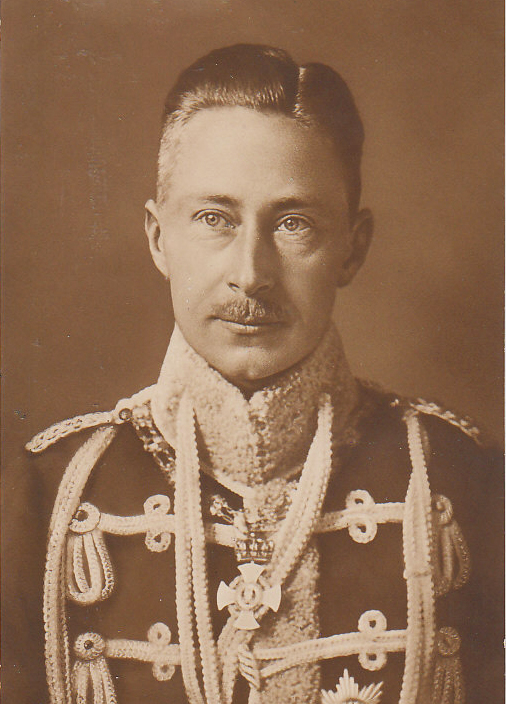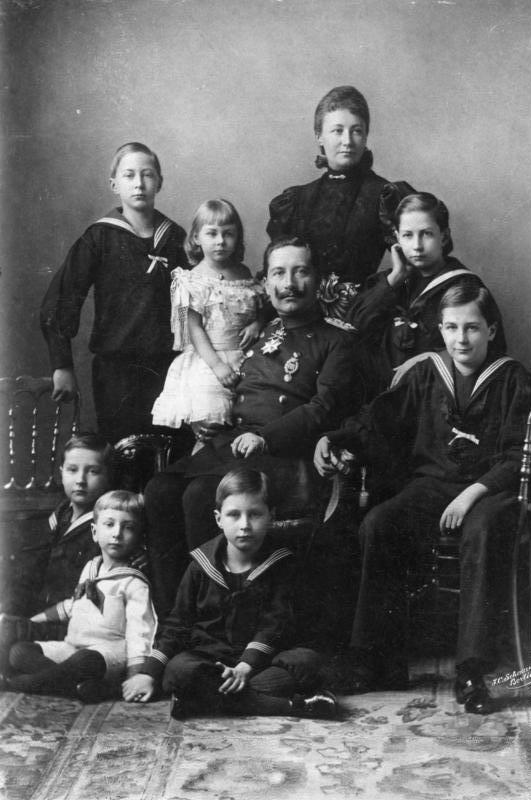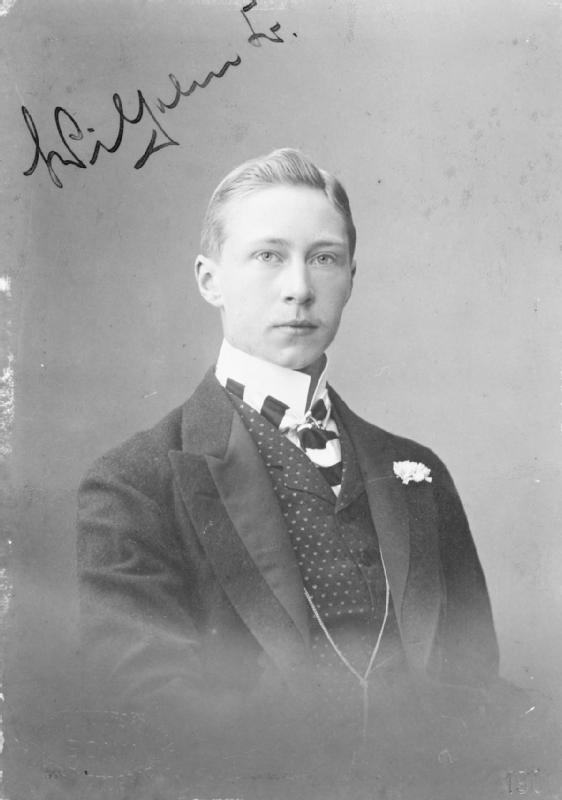by Emily McMahon © Unofficial Royalty 2014

Wilhelm, German Crown Prince, Crown Prince of Prussia; Credit – Wikipedia
The last German Crown Prince and Crown Prince of Prussia was born at the Marmorpalais in Potsdam, Kingdom of Prussia, now in Brandenburg, Germany, on May 6, 1882, a little over a year after the wedding of his parents, the future Wilhelm II, German Emperor and the former Augusta Victoria (Dona) of Schleswig-Holstein. Christened Friedrich Wilhelm Victor August Ernst but known as Wilhelm, he was born during the reign of his great-grandfather Wilhelm I.
Wilhelm had five brothers and one sister:
- Prince Eitel Friedrich (1883–1942), married Duchess Sophia Charlotte of Oldenburg, divorced, no children
- Prince Adalbert (1884–1948), married Princess Adelaide of Saxe-Meiningen, had three children.
- Prince August Wilhelm (1887–1949), married Princess Alexandra Victoria of Schleswig-Holstein-Sonderburg-Glücksburg, had one child
- Prince Oskar (1888–1958), married Countess Ina Marie von Bassewitz, had four children
- Prince Joachim (1890–1920), married Princess Marie-Auguste of Anhalt, had one son
- Princess Viktoria Luise (1892–1980), married Ernst August of Hanover, Duke of Brunswick, had five children including Friederike who married King Paul of Greece

Family of Wilhelm I, German Emperor; Photo Credit – Wikipedia
It was expected that Wilhelm would be called Fritz as it was a common nickname of Friedrich, also the name of both of his grandfathers. The fact that he was called Wilhelm instead did not go unnoticed by his maternal grandmother Empress Friedrich (born Victoria, Princess Royal) and his great-grandmother Queen Victoria. During his childhood, Wilhelm and his siblings were kept from Empress Friedrich, as both his parents disliked her.
Wilhelm attended school in Plön and later the University of Bonn. During his teen years and young adulthood, he gained a reputation as a ladies’ man and would carry on many notable affairs during his lifetime. Wilhelm’s father looked on his son’s promiscuity with strong dislike, at one point more or less banishing young Wilhelm to Danzig to ease the gossip at court. Among Wilhelm’s alleged mistresses were American opera singer Geraldine Farrar and Mata Hari, a dancer and World War I spy.

Wilhelm in 1901; Photo Credit – Wikipedia
Wilhelm spent his time in Danzig playing tennis and having affairs with various women. He also developed an interest in football (soccer), a new sport in Europe. As he became bored at Danzig, Wilhelm began to speak out publicly against his father’s political acumen (or lack thereof). This did not improve the relationship between father and son.

Wilhelm and Cecilie’s engagement photo; Credit – Wikipedia
Wilhelm married Cecilie of Mecklenburg-Schwerin, daughter of Friedrich Franz III, Grand Duke of Mecklenburg-Schwerin and Grand Duchess Anastasia Mikhailovna of Russia, on June 6, 1905, in Berlin. The couple had met at the wedding of Cecilie’s brother the previous year. Cecilie had been selected for Wilhelm by his father due to her close associations with Russia through her mother and because of her noted beauty. Although he did initially take an interest in his wife, Wilhelm soon resumed his affairs with other women.
Wilhelm and Cecilie had six children:
- Prince Wilhelm of Prussia (1906–1940), married Dorothea von Salviati, had two children
- Prince Louis Ferdinand of Prussia, Head of the House of Hohenzollern (1907–1994), married Grand Duchess Kira Kirillovna of Russia, had seven children
- Prince Hubertus of Prussia (1909–1950), married (1) Baroness Maria von Humboldt-Dachroeden, no issue; (2) married Princess Magdalena Reuss of Köstritz, two children
- Prince Friedrich Georg of Prussia (1911–1966) married Lady Brigid Guinness, had five children
- Princess Alexandrine of Prussia (1915–1980), unmarried
- Princess Cecilie of Prussia (1917–1975), married American architect Clyde Kenneth Harris, had issue

Wilhelm with his wife and children, circa 1925; Credit – Wikipedia
Princess Alexandrine had Down’s Syndrome, but unlike most disabled royal children of the time, she was not separated from the family nor was her education neglected. Alexandrine appeared in most family photographs and attended a special school for girls with learning difficulties.
Despite his place in the German militaristic culture, Wilhelm had little interest in the military. He was named commander of the 5th Army at the outbreak of World War I in the summer of 1914, a post he held for two years. He was also the commander of the Army Group German Crown Prince until the end of the war. For the most part, Wilhelm remained under the tutelage of more experienced military commanders during his tenure.
Wilhelm went into exile in the Netherlands following the ending of the monarchy in 1918. Wilhelm and Cecilie returned to Germany five years later, after promising to remain out of politics. The family was able to retain much of its wealth and even some former residences, allowing them to live a comfortable life in Germany. By this time Wilhelm and Cecilie had separated but did maintain friendly relations and reunited during family events.
Wilhelm did not entirely remain out of politics despite his promise, as he met with and supported Adolf Hitler in his early days of power. He also joined Stahlhelm, a German paramilitary organization, and considered running for President of Germany until he was discouraged by many people. Following the Night of the Long Knives in which many political figures were murdered, Wilhelm stayed out of politics permanently.
Wilhelm became head of the House of Hohenzollern in 1941, upon the death of his father. He did not support Hitler’s activities after 1934 and lived a quiet life. After Cecilienhof, the family home, was seized by the Soviets following World War II, Wilhelm moved to a small house in Hechingen, Germany. He died of a heart attack there on July 20, 1951, at the age of 69. Wilhelm is buried with his wife at Hohenzollern Castle in Bisingen, Zollernalbkreis, Germany.
This article is the intellectual property of Unofficial Royalty and is NOT TO BE COPIED, EDITED, OR POSTED IN ANY FORM ON ANOTHER WEBSITE under any circumstances. It is permissible to use a link that directs to Unofficial Royalty.

